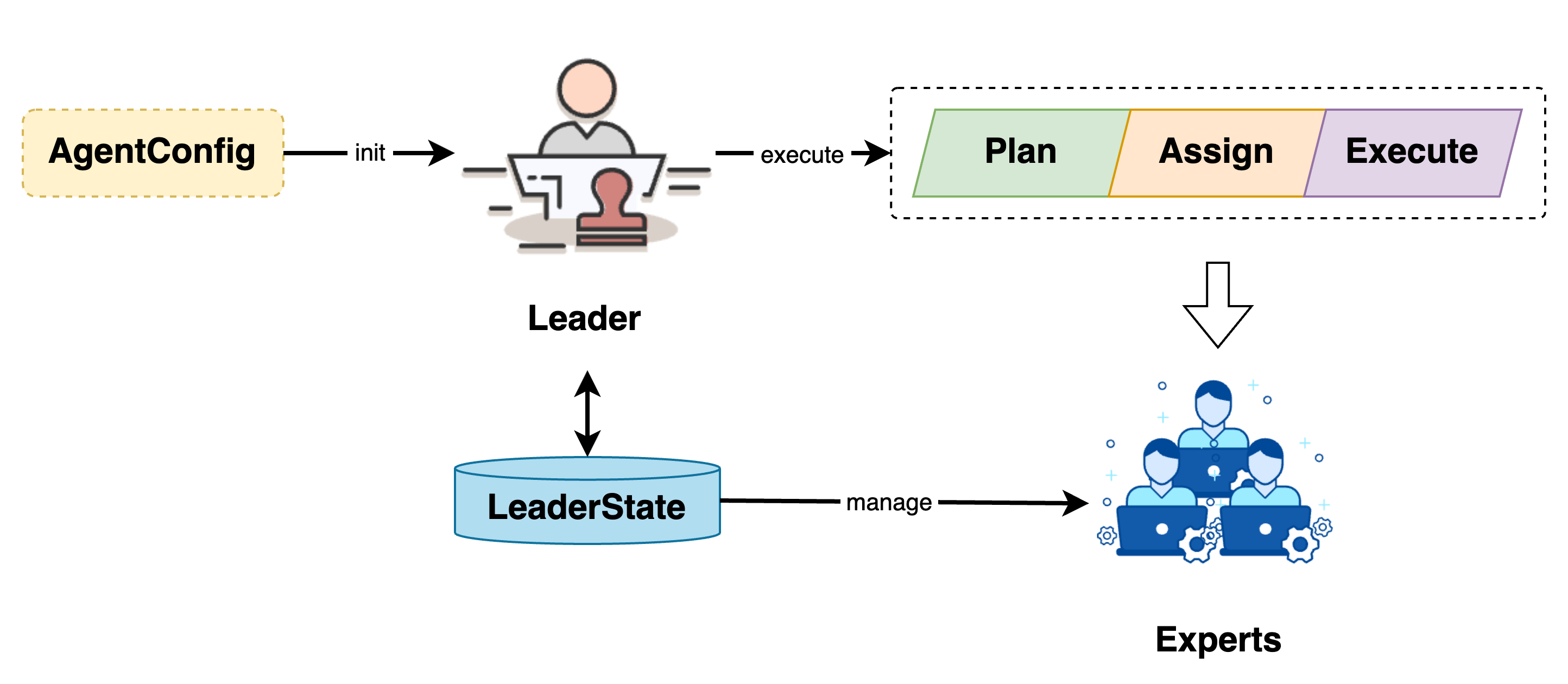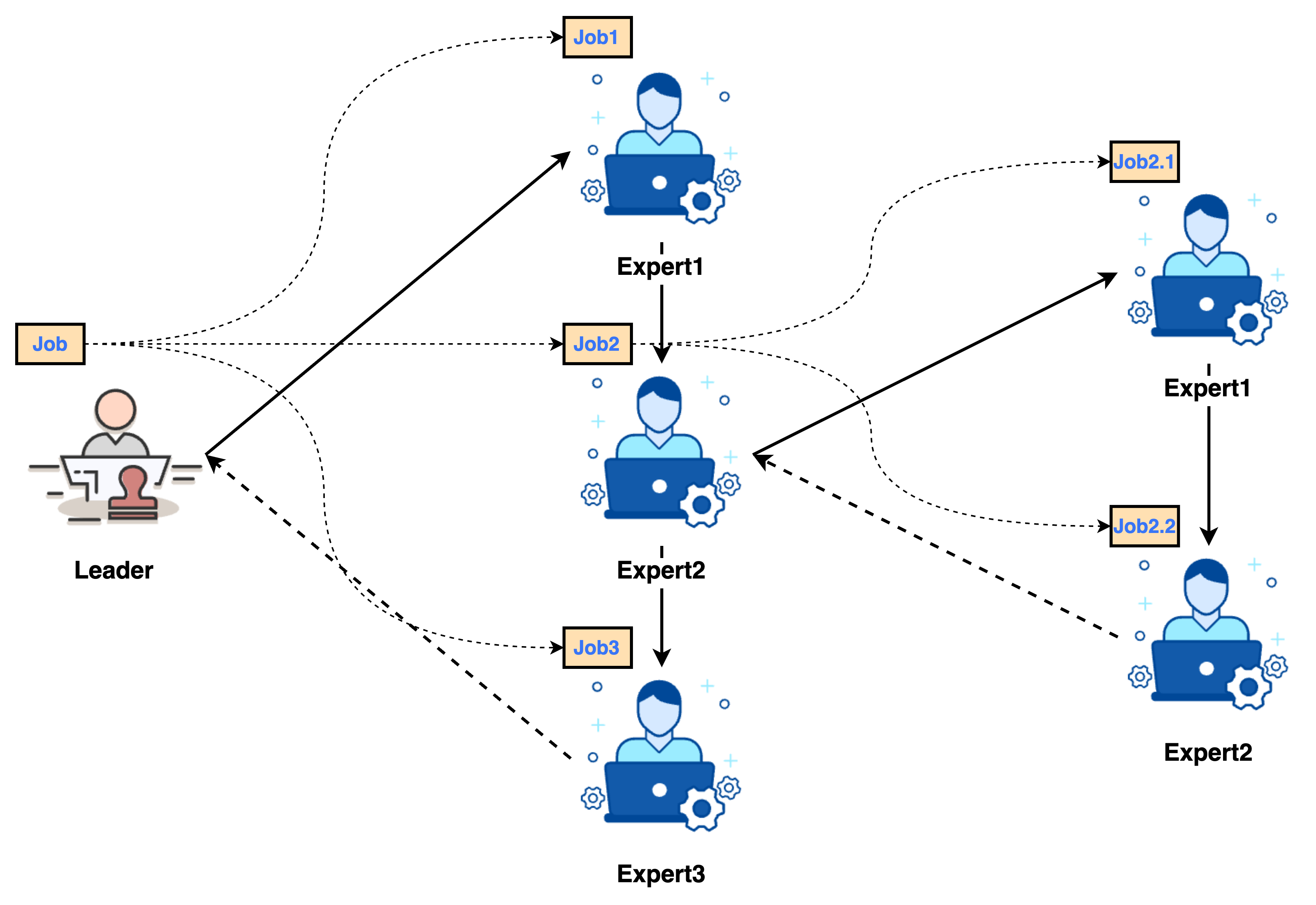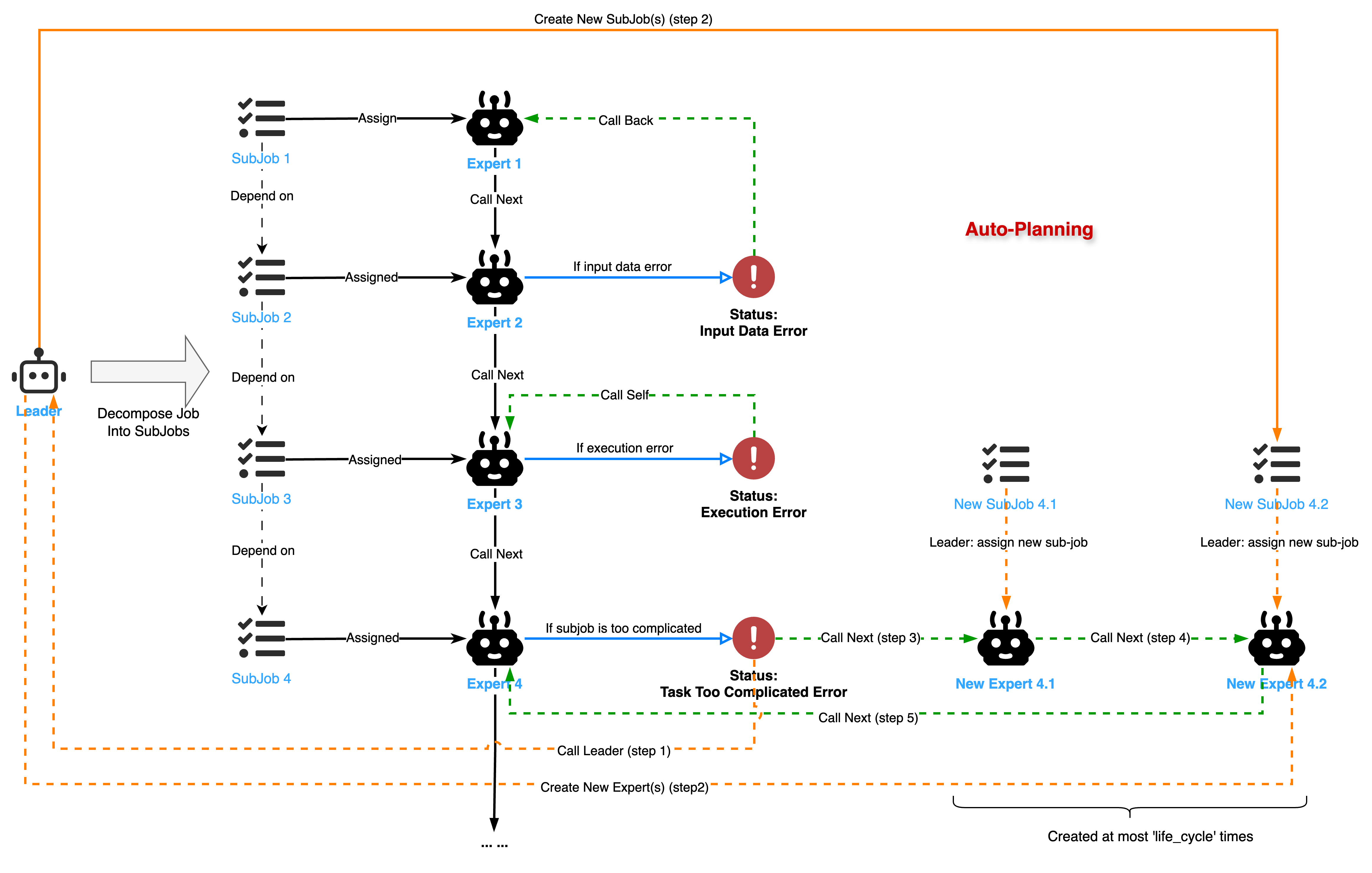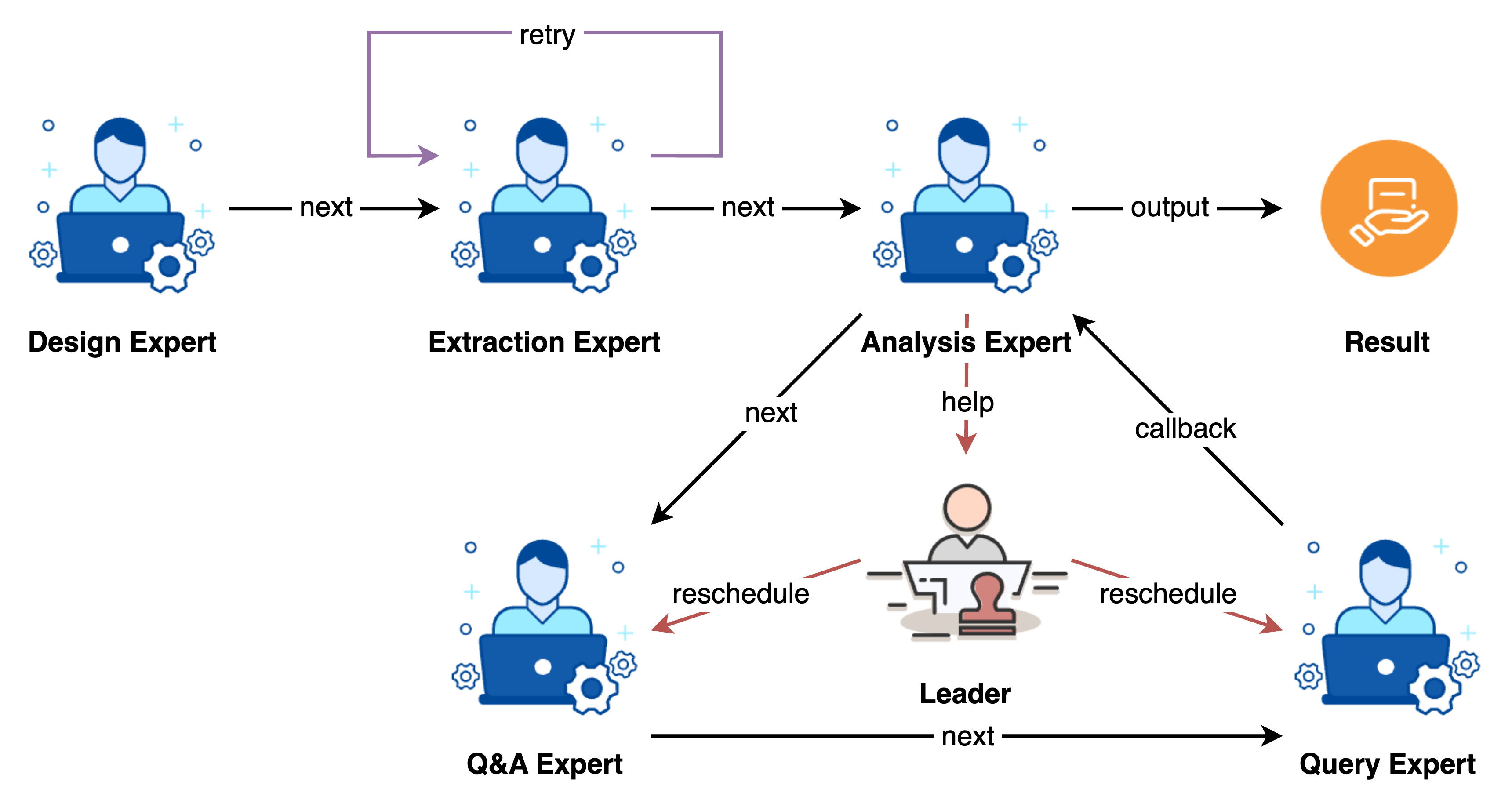Leader
1. Introduction
As the core component and main entry point of the Chat2Graph system, the Leader is responsible for job planning, assignment, execution, and Expert lifecycle management.
2. Design
The Leader is initialized via AgentConfig and manages Expert lifecycles through LeaderState. After receiving a job, the Leader processes it through three phases: job planning, job assignment, and job execution.

2.1. Planning
The agent planner primarily handles job planning and decomposition. Unlike traditional linear planners in agent systems, Chat2Graph employs a graph-based planner that breaks down agent jobs into executable units while preserving dependencies between subjobs, better accommodating execution uncertainties.

The planner's core lies in a carefully designed prompt, JOB_DECOMPOSITION_PROMPT, which guides the Leader to decompose a main job (Given Task) into executable subjobs. The Leader first combines conversation history with the current system state to infer the user's true intent and expected next logical step. Based on this inference, the Leader determines the target expert (Expert) and actions required to complete this step. Task decomposition is its sole output—even with incomplete information (e.g., if the user forgot to upload a file), it must create subjobs for relevant experts and note potential issues in the subjob context. During decomposition, the LLM should aim for the minimal necessary logical subjobs while ensuring assignments are limited to predefined experts. Each subjob must contain all essential information, remain role-neutral, and strictly adhere to the original job scope. For simple jobs or those requiring only one expert, a single subjob should be generated.
Upon receiving an OriginalJob, if no preset Expert exists, the Leader decomposes it into a subjob graph (JobGraph). This graph is a Directed Acyclic Graph (DAG) where nodes represent subjobs (SubJob) and edges represent dependencies between them.
If the
OriginalJobhas a presetExpert, theLeaderskips decomposition and directly assigns the job to thatExpert, resulting in a single-nodeJobGraph(the original job itself).
Chat2Graph explicitly defines subjob fields (see JOB_DECOMPOSITION_OUTPUT_SCHEMA) and uses JobGraph to express dependencies between subjobs.
| Field | Description |
|---|---|
goal | The goal, which must precisely reflect the user's latest request. |
context | Context, including a summary of conversation history, user feedback, and how this context shapes the current job. |
completion_criteria | Completion criteria, which must be clear, measurable, and directly address needs or corrections highlighted in the conversation history. |
dependencies | Dependencies, defined only when generating multiple subjobs to establish relationships between them, forming a JobGraph managed by JobService. |
assigned_expert | The assigned expert's name, indicating which expert will handle this subjob. |
thinking | Reasoning process, requiring the LLM to explain in first-person why this subjob is necessary, its preliminary approach, and key considerations. |
2.2. Assignment
During job assignment, the Leader assigns subjobs organized in the JobGraph to corresponding experts for execution.
- Parallel Task Scheduling: The
Leaderuses a thread pool to parallelize subjobs without dependencies or whose dependencies are already met. It continuously monitors job status, submitting subjobs for execution once all their predecessors complete. - Expert Assignment: Each
SubJobis dispatched to its designatedExpert. TheExpertexecutes its internalWorkflowto process the subjob.

2.3. Execution
We use a state machine to explain the transfer and transition mechanism between Job/SubJob and Agent.

After an Expert completes a SubJob, it returns a WorkflowMessage containing workflow_status, which determines subsequent actions:
SUCCESS: The subjob completes successfully. TheLeaderrecords the result, updates theJobGraphstate, and may trigger execution of dependent jobs.EXECUTION_ERROR: An internal error occurs duringExpertexecution (e.g., API request failure). TheLeaderdecides whether to retry based onretry_count. If retries are exhausted, the subjob and entireJobGraphmay be marked asFAILED.INPUT_DATA_ERROR: TheExpertidentifies invalid input data and cannot proceed. TheLeaderrequeues this subjob and its dependencies, potentially attaching alesson(feedback) for predecessor jobs to correct their output.JOB_TOO_COMPLICATED_ERROR: TheExpertdeems the subjob too complex to handle alone. TheLeadertreats this subjob as a newOriginalJob, decomposing it further into smaller subjobs and updating theJobGraph. To prevent infinite decomposition, subjobs have alife_cyclecounter that decrements with each decomposition until zero.
When all subjobs in the JobGraph complete successfully, the original job is marked as done. If any critical subjob fails or execution is interrupted (e.g., via fail_job_graph or stop_job_graph), the original job is marked as FAILED or STOPPED, respectively.
This state machine enables parallel processing based on dependencies while providing adaptability and error recovery. Additionally, JobGraph supports interruption (stop_job_graph) and resumption (recover_original_job), making multi-agent collaboration under the planner more flexible and controllable.
3. API
The Leader Agent provides the following core APIs.
| Method Signature | Description |
|---|---|
execute(self, agent_message: AgentMessage, retry_count: int = 0) -> JobGraph | Core job decomposition method. Accepts an AgentMessage containing a job (either an original job or a subjob needing further decomposition). If the job has a preset expert, it creates a single-node JobGraph; otherwise, it uses internal Workflow and Reasoner to decompose the job into a JobGraph. Includes validation and retry logic based on lesson. |
execute_original_job(self, original_job: Job) -> None | Accepts an OriginalJob. Updates its status to RUNNING, decomposes it into a JobGraph via execute, stores the graph in JobService, and executes it via execute_job_graph. |
execute_job_graph(self, original_job_id: str) -> None | Executes the JobGraph associated with original_job_id. Uses ThreadPoolExecutor to parallelize subjobs without pending dependencies. Handles post-execution WorkflowStatus (e.g., SUCCESS, INPUT_DATA_ERROR) to update the graph or reschedule jobs. |
stop_job_graph(self, job_id: str, error_info: str) -> None | Stops the entire JobGraph related to job_id (original or subjob ID). Marks the original job and all unfinished subjobs as STOPPED, logging the error. Running jobs are not forcibly interrupted but will update their status upon completion. |
fail_job_graph(self, job_id: str, error_info: str) -> None | Marks the specified job_id as FAILED (if no final result exists), then invokes stop_job_graph to halt the entire graph and mark other jobs as STOPPED. |
recover_original_job(self, original_job_id: str) -> None | Resumes a previously STOPPED original job. If undecomposed (no subjobs), resets status to CREATED and re-invokes execute_original_job. If decomposed, sets the original job to RUNNING, resets STOPPED subjobs to CREATED, and re-invokes execute_job_graph. |
state(self) -> LeaderState (property) | Retrieves the Leader's state object (LeaderState), which manages runtime information like available Expert lists. |
4. Example
Below demonstrates a typical graph data job processing scenario:

Here are some code examples:
- Leader executes string processing tasks:
test/example/agent/run_leader_v1.py - Leader executes natural language processing tasks:
test/example/agent/run_leader_v2.py
